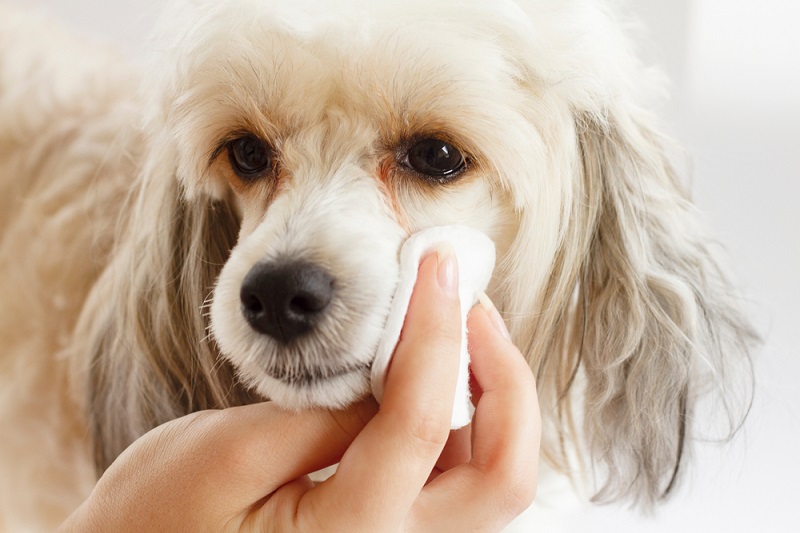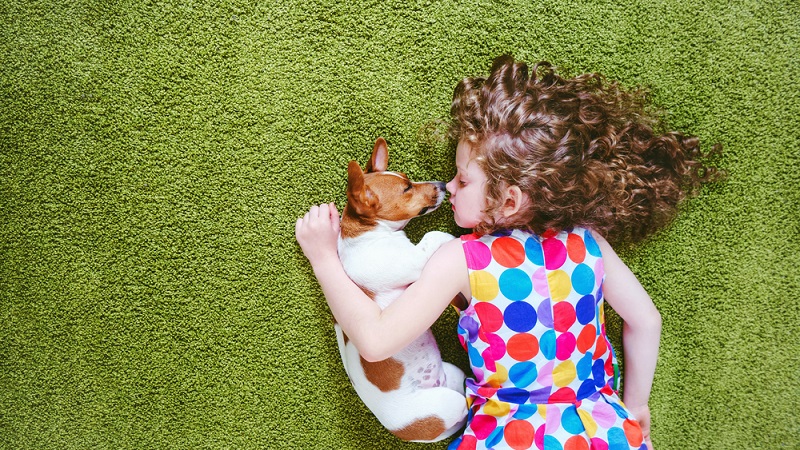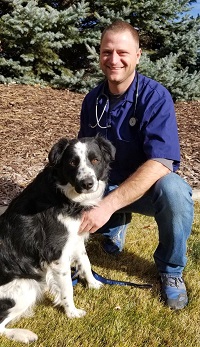You’re not the only one getting itchy eyes during allergy season – pets, including dogs, can experience eye irritation too, whether from pollen or even tear duct issues.
Some breeds or dogs are more prone to experiencing eye issues than others, but whether your dog’s issues are frequent or occasional, eye care should always be a part of your at-home care routine.
How to Identify Dog Eye Problems
Keeping your dog’s eyes healthy and clean is essential for their overall wellness, and knowing how to do this properly can prevent future issues. It’s important to keep an eye out for occasional or recurrent eye issues, as either can quickly develop into a more serious health concern.
Common Symptoms of Eye Issues Include:
1. Irritation
If your dog is holding one eye partially or completely shut, or is pawing at his eye, he is experiencing pain and irritation.
2. Tear Stains
It’s common for light-colored dogs to develop brown tearstains in the lower corners of their eyes. Tearstains are most often caused by the anatomy of their eyes, which makes it difficult for tears to drain normally. Breeds like Chihuahuas and Pekingese with rounded eyes are particularly prone to this problem, as well as breeds with a lot of hair surrounding the eyes.
3. Eye Boogers
“Eye gunk” can form in the corner of a dog’s eye, making him prone to bacterial infections. Regular cleaning can remove such gunk and help keep dog eyes and clean.
4. Difficulty Seeing
Dogs need their vision to navigate, and difficulties may indicate underlying concerns. If you notice your dog is running into objects or is hesitant or fearful in the dark, he may be having an issue with his sight. Most dogs go blind gradually and learn to cope with their inability to see, but a more sudden loss of sight can create anxiety in your dog. If you suspect a problem with his vision, make an appointment with your veterinarian.

How to Clean Your Dog’s Eyes
A clean eye is a healthy eye, and gentle care can make all the difference. To clean your dog’s eyes, flush each eye several times with a properly formulated eye wash for dogs in order to clear out any irritants or debris. If the irritation continues, bring your dog to the veterinarian for an examination. Regularly flushing your dog’s eyes is a good practice to prevent irritation, keep eyes clean and reduce the risk of infection, especially if your dog is often in dirt, dust or water.
Watch the video below for a step-by-step tutorial from our veterinarian, Dr. Mindy Mayfield Davis, on how to safely clean your dog’s eyes.
How to Clean Tear Stains
To clean and combat dog tear stains, use a cloth dampened with an eye rinse or a commercial wipe designed for this purpose. If your dog’s tear stains are caused by a blocked tear duct (a common sign of this is tearing in only one eye), he will need to see a vet.
How to clean dog eye boogers
To prevent eye boogers from causing an infection, regularly rinse your dog’s eyes when mucous forms or irritation seems to occur. Always remember to gently wipe away any eye discharge with designated eye wipes. Learn more about what causes dog eye discharge to get ahead of buildup.
How to Prevent Dog Eye Problems
A vet’s tips can provide the best way to maintain eye health. As with all health problems, prevention is key. When it comes to eye troubles some issues can’t be avoided, such as breed-related eye structure or eye disease passed along through genetics.
In addition to regular cleaning, these preventative measures can help to prevent eye infections and other issues:
Trim Hair Around Eyes
Excess hair around your dog’s eyes can increase his chances of developing eye irritation or infection. A veterinarian or professional groomer can trim away the hair surrounding your dog’s eyes using a blunt-nosed scissor. Please do not attempt to cut hair around your animal’s eyes as you may cause injury. Seek the help of a professional groomer or veterinarian.
Protect Their Eyes
When bathing your dog with a medicated shampoo or flea-killing product, use a dropper to apply an ophthalmic gel made especially for pets to his eyes beforehand to prevent shampoo or chemicals from causing irritation. To prevent injury to your dog’s eyes, do not allow your dog to stick his head out of the car window while it’s moving, as particles and debris could come in contact with his eyes—scratching his cornea or causing other irritation.

Know What Symptoms to Watch For
Keep a close eye on your dog for any eye irritation, infection or loss of vision. Don’t hesitate to contact your veterinarian if you suspect your dog has an eye problem. Stay educated on common signs that a dog is in pain to catch eye issues and beyond in their tracks.
These solutions ensure your canine’s eyes remain healthy and prepared to guide them through the day.
If you have any questions about caring for your pet’s eyes, please email our veterinarian. For chronic dog eye issues that do not respond to treatment, please have your dog examined by your local veterinarian.
 Reviewed by Dan Richardson, Veterinarian
Reviewed by Dan Richardson, Veterinarian
Dan Richardson has been a practicing veterinarian for over 10 years. He specializes in surgery and orthopedics. Dan is originally from rural western Nevada and attended the University of Idaho for undergraduate study and Oregon State University for Veterinary School. The Richardson Family enjoys camping and spending time on the water fishing, paddle boarding, or digging their feet in the sand somewhere warm.
Sources:
- ZME Science. Dogs use the “puppy-eyes” to manipulate you into giving them affection and attention and it works. https://www.zmescience.com/science/dogs-puppy-eyes
- Vetericyn Animal Wellness. How To Safely Wash Your Pet’s Eyes With Vetericyn Plus – Veterinarian Dr. Mindy. https://youtu.be/LjVvy_F8BI0
- Pet Health Hospital. Combating Dog Tear stains. https://www.pethealthhospital.com/combating-dog-tear-stains/
- Schertz Animal Hospital. The Dreaded Dog Eye Boogers: What to Know. https://schertzanimalhospital.com/blog/the-dreaded-dog-eye-boogers-what-to-know/
- American Kennel Club. How to Clean Dogs Ears & Eyes. https://www.akc.org/expert-advice/health/eyes-and-ears-of-good-grooming/
- ASPCA Pet Health Insurance. Top Eye Problems for Dogs. https://www.aspcapetinsurance.com/resources/top-eye-problems-for-dogs/
- The American College of Veterinary Ophthalmologists. Is My Dog Having Difficulty Seeing? https://www.acvo.org/tips-treatments-tricks/is-my-dog-having-difficulty-seeing
- American Kennel Club Canine Health Foundation. Canine Eye Health. https://www.akcchf.org/canine-health/your-dogs-health/caring-for-your-dog/canine-eye-health.html